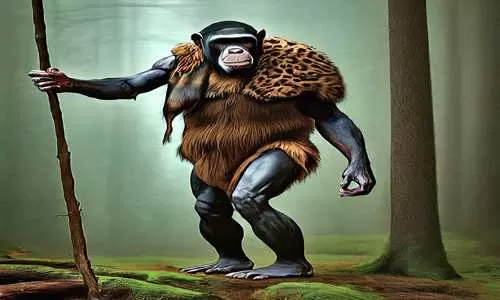Deep in the dense jungles of Sumatra lives a creature that has fascinated locals and intrigued researchers for generations. Known as the Orang Pendek, which translates to “Short Person” in Indonesian, this bipedal creature stands about one meter tall, resembling a small ape or proto-humanoid. Despite its long-standing presence in local folklore, the Orang Pendek remains a mystery, and its existence continues to spark debates among scientists and cryptozoologists alike.
The Legend of Orang Pendek: More Than Just a Myth?
For centuries, the people of Sumatra, particularly around Kerinci-Seblat National Park, have reported sightings of the Orang Pendek. Described as a small, muscular creature with orange fur similar to that of an orangutan, the Orang Pendek is distinctively different due to its human-like posture and bipedal movement. Unlike other apes, which primarily move on all fours, the Orang Pendek walks upright, much like humans. This unique trait raises intriguing questions about our understanding of primate evolution.

Locals who have encountered this creature describe it as strong, with a powerful chest and arms capable of uprooting small trees. Though it primarily feeds on vegetation and small animals, it poses no threat to humans unless provoked. Despite being called the “Short Person,” locals insist it is not human but rather an undiscovered species of ape or primate.
Elusive Evidence: Stories, Footprints, and Speculation
Despite numerous sightings, the Orang Pendek remains elusive. Unlike the Yeti or Bigfoot, no physical evidence—such as bones, fur, or remains—has been found to substantiate its existence. What does exist are countless anecdotes, footprint casts, and local legends. These footprints, often dismissed by mainstream scientists, resemble those of a small child but are considered indirect evidence at best.
The lack of physical proof makes it easy for skeptics to attribute sightings to misidentifications of known animals like orangutans or gibbons. However, those familiar with the jungle insist that the Orang Pendek’s upright gait and unique appearance set it apart from any known species in the region. The ongoing debate continues, fueled by the sheer number of reported encounters and the striking consistency in descriptions over the years.
A Link to Ancient Humanoids? The Discovery of Homo floresiensis

Interest in the Orang Pendek surged following the 2003 discovery of Homo floresiensis, often referred to as the “hobbit,” on the nearby island of Flores. This tiny human species, standing just over a meter tall, coexisted with modern humans until about 12,000 years ago. Some legends even suggest that Homo floresiensis, known locally as the Ebu Gogo, survived until the early 20th century.
The discovery of Homo floresiensis has led some researchers to speculate that the Orang Pendek could be a surviving relative or even the same species. If Homo floresiensis managed to migrate and adapt to the environment of Flores, it is not far-fetched to think a similar species could have found refuge in Sumatra’s impenetrable jungles.
Science vs. Folklore: What Could Orang Pendek Be?
The mystery of the Orang Pendek sits at the intersection of folklore, science, and the unexplored wilds of Sumatra. Could this creature be an undiscovered primate species, a distant cousin of ancient humanoids, or simply a result of misidentified wildlife and embellished tales passed down through generations?
Critics often point out that the lack of physical evidence is a significant barrier to scientific acceptance. However, proponents argue that the remote, dense jungles of Sumatra, combined with the Orang Pendek’s elusive nature, make it entirely plausible that this creature has evaded capture or documentation. Comparisons are often drawn to other cryptids that have crossed into mainstream acceptance, such as the Okapi, once thought to be a mythical beast, and later discovered in the forests of the Congo.
The Ongoing Search for Truth
For now, the Orang Pendek remains a tantalizing mystery, with tantalizing anecdotes but little concrete evidence. Expeditions continue, with researchers combing the jungles for any sign of this elusive biped. Motion-sensitive cameras, footprint analysis, and local interviews are just some of the methods used in ongoing investigations.
Ultimately, the allure of the Orang Pendek lies in its ability to challenge our understanding of human evolution and the boundaries of the natural world. Whether it turns out to be an undiscovered species of ape, a proto-human, or simply a legend born of misidentification and folklore, the Orang Pendek represents the untamed mystery that still lingers in our modern world. Until definitive proof emerges, belief in the Orang Pendek is fueled by hope, curiosity, and the human desire to uncover the unknown.

